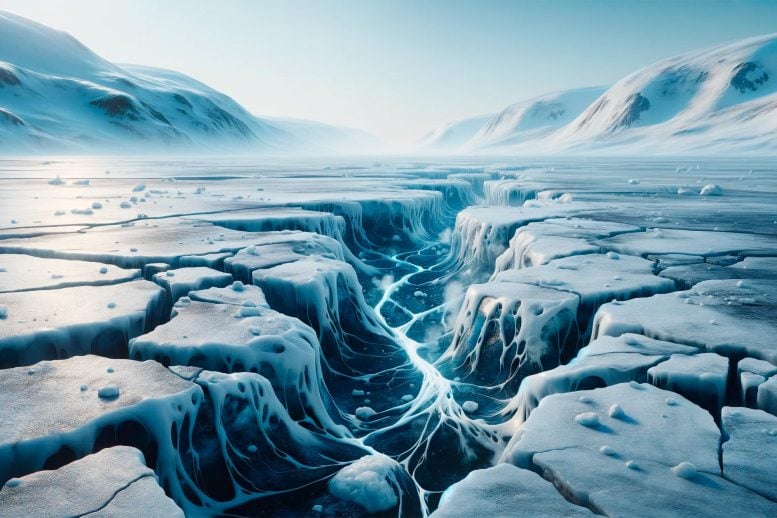The Disturbing Movement of Natural Gas Beneath Permafrost: Unveiling the Methane Time Bomb

A recent discovery by scientists reveals that the methane gas trapped under Svalbard's permafrost has the potential to escape, thereby risking a warming cycle. This is supported by wellbore studies that frequently show methane accumulations, raising concerns over escalating global warming if the permafrost thaws. Credit: SciTechDaily.com
Significant amounts of methane might be trapped under the permafrost, according to scientists. This can be released if the permafrost thaws.
Research in Svalbard indicates that methane is migrating below the permafrost. Ice-rich permafrost found in lowland areas is an effective gas seal, whereas highland regions that contain less ice appear more permeable. This means that excess thawing of the permafrost could cause a release of greenhouse gas emissions, consequently leading to a rise in temperatures.
Underneath the permafrost of Svalbard, there are millions of cubic meters of trapped methane. Scientists have discovered that this can move under the cold seal of the permafrost and get released. A large-scale release can lead to a cycle of warming that increases methane emissions: warming thaws the permafrost, leading to more gas escaping, more permafrost thawing and more gas getting released. Due to similar geological and glacial history between Svalbard and the rest of the Arctic region, there is a likelihood that migrating methane deposits exist elsewhere in the Arctic.
Dr. Thomas Birchall from the University Center in Svalbard and the study's leading author in Frontiers in Earth Science, stated that “methane is a potent greenhouse gas.” He added that the current leakage from beneath the permafrost is minimal. However, factors like glacial retreat and permafrost thawing may increase this leakage in the future.
Permafrost exists throughout Svalbard. It is a form of ground that stays below zero degrees Celsius for two years or more. This permafrost is characterized by varying continuity and uniformity. The west of Svalbard is warmer due to ocean currents, resulting in thinner and possibly more irregular permafrost. High-lying areas have drier and more permeable permafrost, whereas lowland areas have more saturated permafrost. Despite the continuous permafrost, some geographical factors may still allow the escape of gas.
It has been a challenge to study the base of the permafrost due to its inaccessibility. However, there have been many wellbores dug into the permafrost over the years by companies searching for fossil fuels. The scientists carried out a mapping of the Svalbard permafrost and identified permafrost gas accumulations by using historical data from commercial and research wellbores.
According to Birchall, he and his supervisor Kim surveyed the historical wellbore data in Svalbard, and discovered frequent instances of gas accumulations at the permafrost’s base.
Initial temperature measurements can often be skewed due to the heating of drilling mud to prevent freezing of the wellbore. Nevertheless, the scientists managed to identify permafrost by observing the temperature measurement trends and long-term monitoring of the boreholes. They also detected ice forming within the wellbore, changes in drill cuttings produced during drilling, and changes in background gas measurements.
The wellbore monitors spotted gas inflows into the wellbore, signifying accumulations beneath the permafrost. Abnormal pressure measurements showed the icy permafrost functioned as a seal. However, in other cases where the permafrost and underlying geology were theoretically suited for gas trapping, and the rocks were known hydrocarbon sources, no gas was present. This implies that the produced gas had already migrated.
The scientists pointed out that the occurrence of gas accumulations was more commonplace than anticipated. Of the 18 hydrocarbon exploration wells drilled in Svalbard, eight showed signs of permafrost and half of them discovered gas accumulations.
Birchall stated, “All the wells that encountered gas accumulations did so by coincidence...These things seem to be common,” narrating an incident from a recently drilled wellbore near Longyearbyen airport where drillers detected a bubbling sound coming from the well. Consequently, they inspected the well with rudimentary alarms designed for detecting explosive levels of methane, which were instantly set off when held over the wellbore.
Experts have shown that the active layer of permafrost — the upper one or two meters that thaws and re-freezes seasonally — is expanding with the warming climate. However, we know less about how the deeper permafrost is changing, if at all. Understanding this is dependent on understanding the fluid flow beneath the permafrost. If the consistently frozen permafrost grows thinner and patchier, this methane could find it ever easier to migrate and escape, possibly accelerating global warming and exacerbating the climate crisis.




